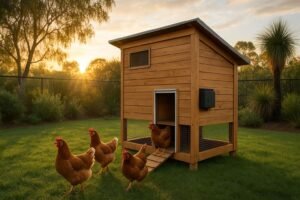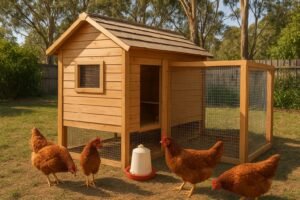If you’re keeping backyard chickens in Australia, you’ve probably watched your flock enthusiastically peck at weeds, wondering: ‘Is this safe?’ Understanding safe Australian native plants and weeds your chickens can eat is crucial for flock health and biosecurity. While chickens have natural foraging instincts, they can’t always distinguish between nutritious greens and deadly toxic plants like oleander or avocado.
In this comprehensive guide, you’ll discover 45+ safe plants and weeds for all Australian climates—from tropical Queensland to temperate Tasmania—including native species like mulberry and wattle, common garden weeds like dandelions and chickweed, and health-boosting herbs that improve egg production. I’ll also cover the 15 most dangerous toxic plants in Australian gardens based on verified research and my own three years keeping Rhode Island Reds in Melbourne. Let’s ensure your chooks have safe, nutritious foraging options year-round.
Why Plant Safety Matters for Australian Biosecurity
This isn’t just about happy chooks; it’s a serious animal welfare issue. Recent research from the University of Adelaide revealed that most Australian backyard chicken owners don’t take their birds to vets due to cost considerations. A peer-reviewed study published in Anthrozoös journal found that this is partly because owners are motivated by a distrust of commercial food systems and see their chooks as both pets and food sources, complicating decisions on vet care. This makes preventing poisoning through proper plant selection even more critical—you can’t just rely on a vet visit to fix a mistake. Additionally, Australian biosecurity regulations are strict.
International best practices, such as USDA research on backyard poultry biosecurity, show that preventing disease outbreaks like avian influenza is a key part of flock management. This is all part of fundamental biosecurity practices for backyard chickens. While there are no specific laws about what you can or can’t plant in your run, poisoning incidents can attract council attention and affect your ability to keep chickens.
If you’re just beginning your journey with chickens, understanding plant safety is one part of creating a healthy environment—alongside proper coops, feed, and knowing the overall costs of starting backyard chickens in Australia.
What “Plant Biosecurity” Means for You
When we talk about “biosecurity,” it sounds like something for big commercial farms, but it’s just as important in your backyard. In this context, it means:
- Quarantining New Plants: When you buy a new plant from a nursery, don’t plant it straight in the run. Keep it separate for a couple of weeks. This ensures you’re not introducing new pests (like mites or lice) or diseases that could have hitched a ride.
- Controlling Wild Birds: While it’s lovely to have native birds around, you don’t want huge flocks of pigeons or sparrows sharing your chicken’s feed and water. They are a primary vector for spreading diseases.
- Managing Visitors: Be mindful of friends who also keep chickens. Diseases can travel on shoes and clothing. It’s good practice to have “run-only” boots that you don’t wear elsewhere.
Plant safety is the first step in good biosecurity. By knowing exactly what’s in your run, you’re controlling the biggest risk factor your chickens face every day.
Now that we understand the “why,” let’s get into the “what.” How do chickens naturally decide what to eat, and how much of their diet should come from foraging?
Should I Feed My Chickens Weeds? Understanding Natural Foraging
It’s a common question for new chicken keepers: “Should I feed my chickens weeds?” The short answer is a big yes! Foraging is just what chickens do. It’s not just optional; it’s essential. When your chooks are scratching in the dirt, pecking at leaves, and chasing bugs, they aren’t just eating—they’re staying entertained, exercising, and balancing their own diet.
Look, pellets are great, but a varied diet is vital for Australian backyard chooks. Greens give them essential vitamins and minerals (like Vitamin A and K) that can be missing from standard feed, which leads to brighter egg yolks and healthier birds. Plus, letting your chickens eat weeds means less work for you and a lower feed bill. This is a significant benefit, as University agricultural extension research shows that feed accounts for approximately 70% of chicken-keeping costs.
However, this comes with a big warning. While chickens are pretty smart, they are not 100% reliable at avoiding toxins. Some chickens will instinctively avoid bitter-tasting poisonous plants, but others (especially young birds) will try anything once. I’ve seen my own chooks eat screws and Styrofoam, so… yeah, we absolutely cannot trust them to know best. Your job as the flock manager is to be the brain of the operation: remove the bad stuff, encourage the good. Beyond just allowing access to safe plants, you can actively improve your chickens’ foraging experience by encouraging natural foraging behavior in your flock through environmental enrichment and strategic garden design.
The 80/20 Rule: Balancing Pellets and Forage
Here’s the most important rule: forage is a supplement, not a replacement. Commercial layer pellets are a “complete feed,” meaning they have the precise balance of protein, calcium, and nutrients a hen needs to lay eggs and stay healthy.
Think of it like this: pellets are the “main meal,” and everything else—weeds, herbs, kitchen scraps—is “dessert” or a “side salad.”
A good guide is the 80/20 rule:
- 80-90% of their diet should come from their complete layer feed.
- 10-20% of their diet can come from safe foraging, weeds, and scraps.
If you give them too many “treats,” they’ll fill up on the fun stuff and skip their essential pellets. This can lead to nutritional deficiencies, soft-shelled eggs (from lack of calcium), and other health problems.
So, providing a rich, green environment is fantastic, but always make sure their feeder with their main pellets is available.
With that balance in mind, let’s explore the best Australian native plants that are perfect for your chicken run.
Australian Native Plants Your Chickens Can Safely Eat
When planning a chicken-friendly garden, Australian native plants are a brilliant, water-wise choice. They’re already built for our crazy climates and give your flock great shade, shelter, and food.
Best Australian Native Trees for the Chicken Run

- Wattle (Acacia species): Wattles are brilliant for dappled shade. Their seeds are very high in protein, and you’ll often see your chooks foraging for them on the ground.
- CRITICAL WARNING: You must identify the species. Only certain wattle varieties have edible seeds. Some, like the Cootamundra Wattle (Acacia baileyana), have toxic seeds. Always consult a local native nursery to ensure you are planting an edible-seed-variety.
- Mulberry Trees: These are, hands down, one of the best choices. They grow well in most Australian climates, and the chickens love both the fallen berries and the leaves. My chooks go into a frenzy when the mulberries drop! Because they are deciduous, they let in winter sun and help prevent parasite buildup in the soil beneath. They also provide fantastic shade and hiding spots.
- Moringa (Moringa oleifera): Often called the “miracle tree,” moringa grows like mad in tropical to semi-arid parts of Australia. Its leaves are packed with nutrition—we’re talking up to 38% protein. There are even scientific studies showing that moringa in feed can improve chicken health and performance.
- Lilly Pilly (Syzygium species): A very common Australian hedging plant. The berries are perfectly safe for chooks (and humans!). They’ll happily clean up any fallen fruit.
Native Shrubs and Clumping Plants
- Native Lemon Grass (Cymbopogon species): This is different from the common culinary lemon grass. Native lemon grass forms large, hardy clumps that chooks love for cover and nesting. One of my hens always set up a secret nest in our lemon grass clump. It’s surprisingly good for weather protection and can be cut for mulch.
- Queensland Arrowroot (Canna edulis): Don’t let the name fool you; this hardy clumping plant grows well in tropical and subtropical Australia. Its large leaves offer shade, and chickens enjoy nibbling on them. The leaves also have high plant protein. It needs to be well-established, or the chooks will scratch it up.
Ground Cover Plants Safe for Australian Chicken Runs
- Native Grasses (Lomandra species): In my experience and based on feedback from other Australian chicken keepers, these tough, strappy plants are almost indestructible. Chickens use them for cover and they are very resistant to pecking.
- Kangaroo Grass (Themeda triandra): A beautiful native grass that provides seeds and attracts insects, which your chickens will love hunting.
- Native Violets (Viola hederacea): A lovely, hardy ground cover for shady, damp spots in the run. It’s non-toxic and will create a soft green mat.
How to Source Safe Native Plants: Be careful where you buy your plants. Plants from large chain hardware stores may have been treated with systemic pesticides (pesticides absorbed into the plant), which can be harmful to chickens. Your best bet is to source plants from a local council nursery, a community native plant group, or grow them yourself from seed.
Native plants are a fantastic “set and forget” option for your run, but what about the weeds that are already there? Let’s look at which ones are friends and which are foes.
What Weeds Can Chickens Eat in Australia? Safe Garden Weeds
Many of the plants we pull from our veggie patch are actually highly nutritious for our flocks. Letting your chickens “help” you weed can be a win-win, as long as you know what’s what. In addition to safe garden weeds, you can supplement your flock’s diet with appropriate kitchen scraps and garden waste to provide nutritional variety and reduce feed costs.
Safety First: Never feed weeds from areas that have been treated with pesticides, herbicides, or chemical fertilisers. This includes council verges or parks. Only use weeds from your own organic garden.
Are Dandelions OK for Chickens? Top Nutritious Weeds
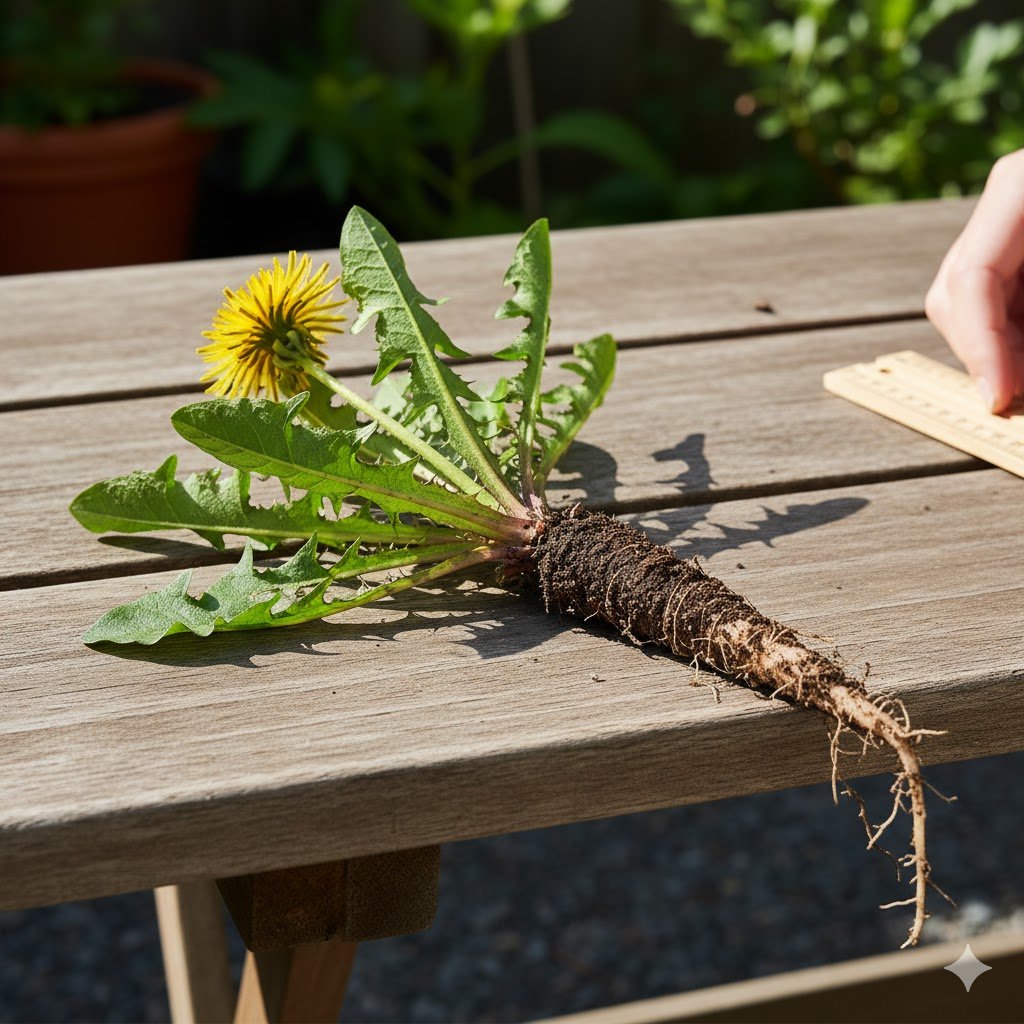
You bet they are! If there’s one “super-weed” for chickens, it’s the humble dandelion.
- What parts are edible? The entire plant: roots, stems, flowers, and leaves.
- Why are they so good? Dandelions are packed with vitamins A, B, C, E, and K, plus iron, magnesium, phosphorus, potassium, and zinc.
- Health Benefits: They’re loaded with calcium, which is perfect for laying hens. They’re also a natural detoxifier, can help with internal parasites, and those yellow flowers? They’re what give your egg yolks that amazing deep orange colour.
- How much? You can feed dandelions in unlimited amounts as a green treat. They grow year-round in many parts of Australia, making them a reliable snack.
Here are other common Australian garden weeds that are safe and nutritious:
- Chickweed: A common, delicate weed in cooler months. It’s high in vitamin B and aids digestive health. Chickens seem to love its tender leaves.
- Clover: That common lawn “pest” is a fantastic chicken feed. It’s high in calcium, niacin, potassium, vitamins A and B, iron, and protein. It’s great for respiratory and circulatory health. A small warning: feed clover in moderation, as it contains coumarins, which can act as a blood thinner in very large amounts.
- Lambsquarters (Fat Hen): A very common garden weed. It’s safe, nutritious, and many chicken keepers report it makes egg yolks darker.
- Purslane: This succulent weed is a favourite. It’s high in omega-3 fatty acids and chickens love its fleshy texture, especially on hot days.
- Plantain (Plantago species): No, not the banana! This is the common flat-leafed weed you’ll find in lawns all over Australia. It’s safe, nutritious, and chickens eat the leaves readily.
Other Australian Weeds Safe for Chickens
Here are a few others to look for (all in moderation):
- Oxalis (Wood Sorrel) – in moderation, as it’s high in oxalic acid.
- Catsear
- Evening Primrose
- Smartweed
- Bitter Cress
- Yellow Dock
How to Safely Harvest and Feed Weeds
While it’s tempting to just throw a pile of weeds into the run, there are safer and better ways to do it:
- The “Wilt” Method: Chop up handfuls of weeds and let them wilt in the sun for 30 minutes. This makes long, stringy stems (like clover or long grass) easier to digest and helps prevent an impacted crop.
- The “Weed Bouquet”: Tie a bunch of dandelions or chickweed with some string and hang it from the run’s ceiling, just high enough that they have to jump for it. This is a great boredom buster.
- The “Chop and Toss”: For tougher weeds like plantain, chop them roughly and mix them with a small amount of their regular feed to encourage them to eat.
CRITICAL SAFETY WARNING: NEVER Feed Lawn Mower Clippings This is one of the biggest mistakes new owners make. A pile of freshly mown lawn clippings ferments very quickly. If a chicken eats this, it can pack down in their crop, ferment, and cause a life-threatening condition called an impacted or sour crop. It’s just not worth the risk.
Weeds are a free, nutritious snack, but you can be even more strategic by planting specific herbs that supercharge your flock’s health.
Best Herbs for Chickens to Eat: Health-Boosting Garden Herbs
Planting herbs in and around your chicken run isn’t just for looks or feed. Many of them have medicinal properties and—let’s be honest—they help keep the coop smelling less like a coop.
- Rosemary: This hardy, drought-tolerant herb is often chicken-resistant, meaning they won’t destroy the growing plant. You can offer dried rosemary for its respiratory health benefits or hang fresh bunches in the coop as an aromatic.
- Lavender: Like rosemary, chickens tend to leave the growing lavender plant alone. It’s calming and aromatic. I always add dried lavender to my nesting boxes to help calm broody hens and keep the space fresh.
- Mint: Chickens love mint, but its best use is as a fly and rodent repellent. Plant it (in a pot, or it will take over!) near the coop. It’s highly aromatic and grows vigorously in most Australian conditions.
- Sage: Another chicken-resistant plant with antioxidant properties. It’s traditionally used to support respiratory health.
- Comfrey: This is a brilliant plant. It’s protein-rich, provides excellent cover, and grows well in most Australian climates. It can be a bit too successful, so plant it where you don’t mind it staying.
- Calendula (Pot Marigold): This is a must-have. Its bright orange and yellow petals are anti-inflammatory. But the best part? They are packed with carotenoids, which will give your egg yolks an incredibly deep orange colour. To answer the common question, “Are marigolds toxic to chickens?” – no, pot marigolds (Calendula) are not only safe, they’re fantastic for them.
- Oregano: This herb is a heavy-hitter. It’s basically a powerful natural antibiotic and is known to combat diseases like coccidiosis, salmonella, and E. coli. You can feed it fresh or dried.
- Parsley: A great source of vitamins, parsley aids the digestive system and is known to act as a laying stimulant.
- Fennel: Another aromatic, chicken-resistant plant that you can offer in moderation.
Three Ways to Use Herbs for Flock Health
Don’t just plant them and hope for the best. Here’s how to make herbs work for you:
- Grow Near the Run: Plant aromatic, pest-repelling herbs like mint (in pots!), lavender, and rosemary around the coop and run. The chickens will brush against them, releasing the oils and helping to deter flies and mites.
- Chop and Mix: Finely chop fresh herbs like oregano, parsley, and calendula petals and mix them into their feed once or twice a week. This is the best way to get those health benefits directly into their system.
- Dry for Nesting Boxes: Hang bunches of lavender, mint, and rosemary to dry. Once dry, crumble the leaves and flowers into your nesting box material. It keeps the space smelling fresh, repels pests, and has a calming effect on laying hens.
Growing herbs is easy and effective. Now, let’s look at some larger-scale plants you can grow specifically for chicken feed and shade, broken down by our diverse Australian climates.
Quick Growing Plants for Chickens: Best Garden Plants by Climate
Beyond weeds and herbs, you can actively grow plants for your chickens. The trick, of course, is choosing plants that will actually survive your local climate. Beyond providing food, shade plants like mulberries and bananas play a crucial role in keeping your flock cool during Australian summers, when temperatures can reach dangerous levels for chickens.
Tropical & Subtropical: Far North Queensland (Cairns, Townsville), Northern NSW (Byron Bay, Lismore), Darwin & Top End NT
- Banana Plants: Chickens love the fruit (in moderation) and will happily forage among the trees, which withstand scratching well. They thrive on the extra nutrients from chicken run-off water and provide amazing shade and a windbreak.
- Choko Vines: Chokos love the rich, nitrogen-heavy soil of a chicken run. The vines can be grown over the coop structure (on strong support, not just chicken wire) to provide fantastic insulation. Chickens will eat the leaves and growing tips they can reach.
- Sweet Potato: A vigorous grower in warm climates, chickens shouldn’t eat the plant in large amounts, but they love the sweet potato itself (cooked is best). The leaves are known to boost immunity.
- Passionfruit: A perfect vine for covering a run. It provides dense shade and the chickens will love pecking at any fallen fruit.
- Queensland Arrowroot: As mentioned earlier, this is a fantastic, hardy clumping plant for warm zones.
Temperate Climates: Southern NSW (Sydney, Wollongong), Victoria (Melbourne, Geelong), SA (Adelaide), Tasmania (Hobart)
- Silverbeet (Beta vulgaris): This hardy leafy green is an absolute staple in my run. It’s full of vitamins and antioxidants. I feed all my lacy or bug-damaged leaves to my flock. To answer, “Can chickens eat silverbeet stalks?” – yes, they can, but like the leaves, it should be fed in moderation due to moderate levels of oxalates.
- Tree Lucerne: A fantastic, fast-growing shrub for temperate areas. Its drooping branches create “hiding caves” that chickens love. The leaves are incredibly high in protein (20-24%). It’s not suitable for heavy, clay soils or tropical climates.
- Tamarillo: This quick-growing shrubby tree provides good dappled shade and will fruit within a couple of years.
- New Zealand Spinach (Warrigal Greens): A very tough, perennial ground cover that survives most temperate winters. It’s safe in moderation (it’s high in oxalates, just like silverbeet) and chickens will peck at it.
All Australian Climates
- Amaranth: This plant is incredibly forgiving; it grows almost anywhere in full sun. The burgundy seed plumes can be dried and hung in the run as a “boredom buster” in winter. It’s high in fibre, protein, and micronutrients.
- Mulberry: As mentioned, this is a winner across Australia.
- Sunflowers: Easy to grow and a fun treat. Chickens love the seeds (a great source of protein and fat) and the large plants provide shade when mature.
Tip: Use a “Chicken Tractor” for Planting Want to plant a new garden bed? Use your chickens! Fence them into the area for a week using a “chicken tractor” (a mobile pen) or temporary fencing. They will weed, de-bug, and manure the entire patch for you. Once they’re done, move them off and you have a perfectly prepared, fertilised bed ready for planting.
Growing the good stuff is fun, but it’s all for nothing if you don’t remove the bad stuff. This next section is the most important one in this entire article.
What Plants Are Poisonous to Chickens? Toxic Plants in Australian Gardens
While chickens can eat many plants safely, certain common Australian garden plants can sicken or kill your flock. Honestly, knowing the bad stuff is just as important as knowing the good stuff. Here’s what to absolutely avoid.
If you suspect your chicken has eaten something toxic, contact your vet immediately. If you suspect your chicken has eaten something toxic and is showing symptoms like lethargy, difficulty breathing, or unusual behavior, it’s critical to know when to call the vet for your backyard chicken rather than waiting to see if symptoms resolve. As Australian veterinary professionals note, backyard chicken owners are often hesitant to seek vet care due to cost, which makes prevention the most important strategy.
Symptoms of Poisoning in Chickens
Look for any of these signs:
- Sudden lethargy, droopiness, or unwillingness to move
- Difficulty breathing, gasping, or panting
- Pale comb and wattles
- Diarrhea (especially bloody, green, or watery)
- Stumbling, loss of coordination, or seizures
- Swelling around the face and eyes
- Sudden death of one or more birds
What to Do if You Suspect Poisoning
- Act Fast. Immediately remove your entire flock from the area to prevent others from eating the plant.
- Isolate. Separate the sick bird(s) in a quiet, warm place with clean water.
- Identify. If you can, find what they ate. Take a photo or a sealed sample of the plant.
- Call Your Vet. This is not a “wait and see” situation. Call your vet, tell them you suspect poisoning, and describe the symptoms and the plant (if you know it).
- Don’t Induce Vomiting. You can cause more harm. Your vet may recommend activated charcoal to help absorb the toxin, but only do this on their advice.
Highly Toxic Plants Common in Australian Gardens
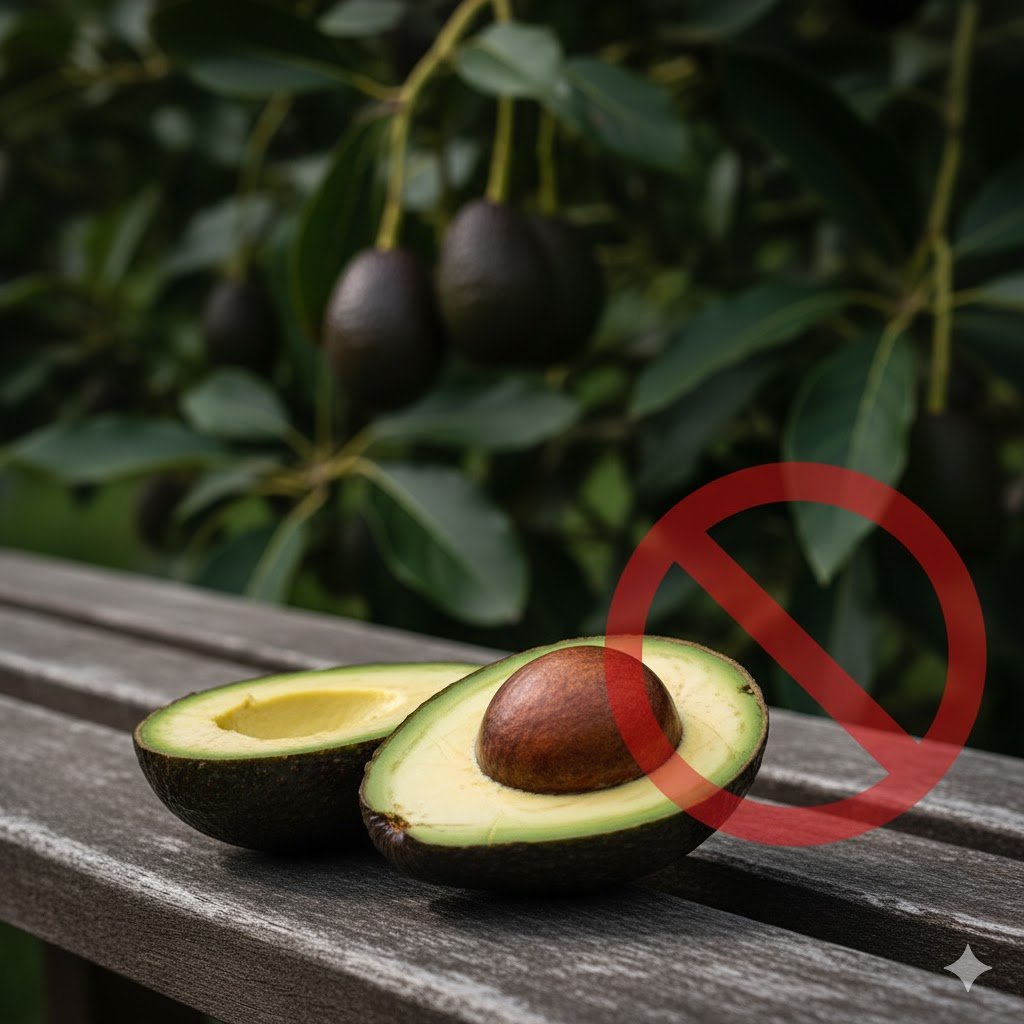
- ⚠️ DEADLY TOXIN: Nightshade Family (Solanaceae) This is the big one. It includes the plants (leaves, stems, vines) of tomatoes, potatoes, and eggplants. They contain a toxin called solanine.
- Is it safe to feed chickens tomatoes? Yes, the ripe, red fruit is perfectly fine.
- Is it safe to feed chickens potatoes? Yes, cooked potato is safe. Never feed raw, green, or sprouted potatoes.
- Keep your chickens securely fenced out of the veggie patch where these are growing.
- ⚠️ DEADLY TOXIN: Avocado The skins and pits are extremely poisonous to chickens. They contain a toxin called persin, which can cause breathing and heart problems, often leading to death within 48 hours. NEVER feed any part of avocado to your flock. It’s not worth the risk.
- ⚠️ EXTREME DANGER: Oak Trees The leaves and acorns are toxic. They contain tannins, which can cause kidney damage. Keep your chooks away from areas with fallen acorns.
- ⚠️ EXTREME DANGER: Oleander Extremely toxic and very common in Australian gardens. All parts of this plant are poisonous and can be fatal in tiny amounts. Remove immediately from any area chickens can access.
- ⚠️ DEADLY TOXIN: Azalea & Rhododendron These common ornamental shrubs are highly toxic. Remove them from any area your chickens can access.
- ⚠️ DEADLY TOXIN: Foxglove A beautiful but deadly cottage garden plant. It contains digitalis, which is highly toxic and affects the heart.
- ⚠️ TOXIC: Bracken Fern Common in Australian bushland. If your chickens free-range near bush areas, be aware that this fern is toxic.
- ⚠️ TOXIC: Common Bulbs Many spring bulbs are toxic, including Daffodils, Tulips, Freesias, and Jonquils. Be especially careful if you let your flock free-range after winter.
Moderately Toxic Plants – Use Caution
- Onions: In large quantities, onions can cause anaemia or jaundice. They contain thiosulphate, which destroys red blood cells. Small amounts in cooked kitchen scraps are generally okay, but never feed them raw or in bulk.
- Apple Seeds: The apple flesh is fine, but the seeds contain small amounts of cyanide.
- Rhubarb Leaves: The stalks are safe (in moderation), but the leaves are toxic due to high levels of oxalic acid.
- Wisteria Seedpods: While some chicken keepers report their flock eating the flowers without issue, the seedpods are known to be toxic.
Elderberry – Special Case
Elderberry bushes are often debated. Here’s the breakdown: the leaves, stems, roots, and immature green fruit all contain cyanide-inducing glycosides. However, many chicken keepers report that their flocks happily and safely eat the mature, ripe black or blue berries. Cooking the berries destroys the toxins.
My verdict? Proceed with extreme caution. The risk from the green parts of the plant is high. If you have an elderberry, it’s safest to fence it off or protect it with chicken wire so your flock can’t access the leaves and stems, and only offer them the ripe, cooked berries as a treat.
Okay, take a deep breath. It seems scary, but the solution is simple: remove these plants or fence them off. Now, let’s get back to the constructive part—how to build a run that protects the good plants you do want.
How to Grow and Protect Plants in Your Chicken Run
So, you’re ready to plant? Here’s the challenge: chickens are programmed to scratch and destroy. You can’t just plant a seedling in the middle of the run and hope for the best.
Protecting Young Plants from Scratching
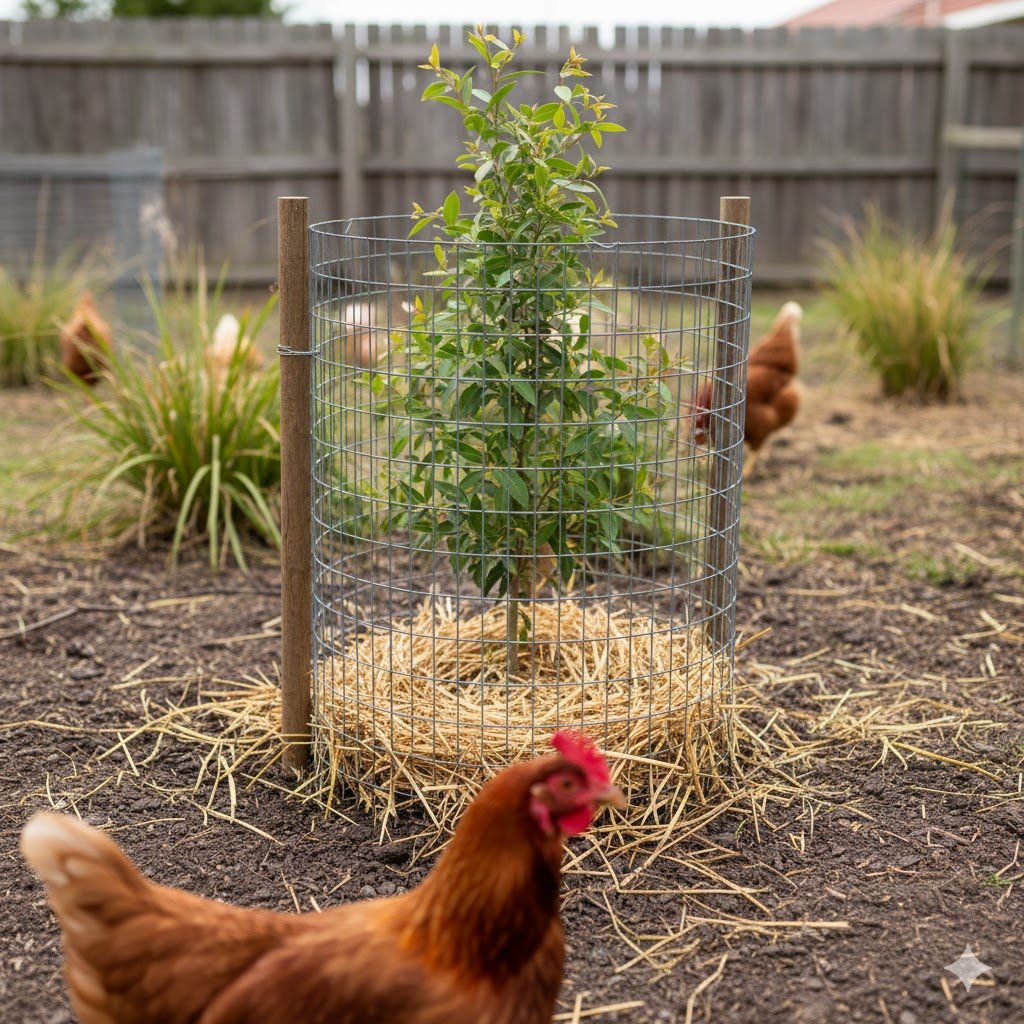
In my experience, only large, established plants will survive unprotected. For everything else, you need a strategy. The level of plant protection you need depends largely on whether to use a chicken run or free-range your flock—contained runs make it easier to establish protected planting zones, while free-ranging requires more strategic garden design.
Here are some methods that work:
- Wrap the base of young trees with wire mesh.
- Use a section of wide PVC tube around the seedling.
- Plant larger shrubs just outside the run, so they can provide shade and drop leaves/berries into the run safely.
- Pile large branches or logs around the base of the plant.
- Build a small frame with bird netting over a poly pipe hoop to protect the plant for its first year.
- An old bucket with the bottom cut out works well as a mini-tree guard.
Multi-Layer Planting Strategy
I’ve found the most successful chicken runs use a multi-layer system, just like a natural forest. This creates a more engaging, safe, and resilient environment for your flock.
- Canopy: Start with tall trees for high shade (like a Mulberry or a suitable Wattle).
- Mid-Level: Add shrubs for cover and hiding spots (like Tree Lucerne or Elderberry if protected).
- Ground: Establish hardy ground covers and clumping plants (like Arrowroot or Lemon Grass) where your chickens love to rest.
This strategy differs by climate. In Far North Queensland, your focus might be a dense, year-round canopy with plants like bananas and moringa to provide critical shade from the intense sun. In Victoria or Tasmania, a deciduous canopy from a mulberry tree is a smarter choice, as it provides shade in summer but lets the precious (and sanitising) winter sun hit the ground. I’ve found my chooks use all three layers: sunning themselves on the open ground, hiding from hawks under the Tree Lucerne, and waiting for berries under the mulberry.
What Is the Best Thing to Put on the Ground in a Chicken Run?
A bare-dirt run gets muddy in winter and dusty in summer. What you really want to aim for is a deep-litter system.
- Straw or Lucerne: This is a great choice. You can add fresh layers on top, and the chickens will help turn it over. The whole lot can go straight into your compost bin with the droppings.
- Wood Shavings: These also work well but decompose slower, so they need a longer composting time. Avoid treated wood.
- Dust Bath: Setting up a proper dust bath area is essential for parasite control and gives your chickens a designated scratching zone away from your carefully planted areas. A mix of dry dirt, sand, and a little wood ash is perfect.
The “Deep Litter Method” – A Plant-Lover’s Best Friend
This method is the single best way to manage a chicken run. Instead of cleaning out the coop and run poos every week, you just add more carbon material (like dried leaves, straw, or wood shavings) on top.
The “browns” (carbon) mix with the “greens” (manure) and the chickens’ scratching action turns it all into amazing, rich compost in place. It’s less work, it doesn’t smell, and it creates a healthy soil microbiome. Once or twice a year, you shovel out the bottom layers and you have “black gold” compost for your veggie patch. (Note: It’s too “hot” or nutrient-rich to use directly on plants, so let it age in a compost pile for a few months first).
A well-managed run is great, but a fun run is even better. Let’s look at how to use plants for entertainment.
What Are the Boredom Busters for Chickens? Using Plants for Enrichment
A bored chicken is a destructive chicken. They’ll start pecking each other, eating eggs, and trying to escape. Using plants for enrichment keeps their minds busy.
- The “Cabbage Piñata”: Hang a whole cabbage, head of lettuce, or broccoli from a string so it dangles just at their head height. They will spend hours pecking at it.
- Leaf Piles: In autumn, just rake a big pile of dry leaves into their run. It’s a free boredom buster. They will happily spend days shredding the pile, scratching for bugs, and taking dust baths in it.
- Seed Log: Get a pinecone, roll it in molasses or peanut butter (sparingly), and then roll it in safe seeds (like sunflower seeds, millet, and their regular pellets). Hang it up as a special treat.
- Dried Seed Heads: Hang dried amaranth seed heads or whole sunflowers in the run.
- Decomposing Trunks: **Leave decomposing banana trunks in a corner—they will attract insects, and your chickens will go nuts foraging for them.
- Varied Terrain: **Create varied terrain with clumping plants and logs for them to jump on. Chickens love having different levels to explore.
- Nesting Spots: Clumps of lemon grass or native grasses create hideaways and private nesting spots, which hens love.
While we’re focused on plant safety today, the bigger picture of protecting your flock from Australian predators like foxes, snakes, and birds of prey requires strategic planning of both your coop and the surrounding plantings that can provide shelter or attract predators.
Enrichment is especially important in winter, when fresh greens are scarce. Let’s look at how to preserve the summer bounty.
Best Dried Herbs for Chickens to Eat: Preserving for Winter
During the flush of spring and summer, you’ll have more greens than you know what to do with. In winter, especially in temperate states like Victoria and Tasmania, fresh greens can be scarce.
Dried Herbs for Chickens to Eat
That’s where drying comes in. It’s easy to preserve the goodness of herbs for winter.
- What to dry: Dandelions, calendula, oregano, parsley, and mint are all great choices based on their health benefits mentioned earlier.
- How to dry: Tie them in small bunches and hang them in a dry, airy place out of direct sunlight. You can also lay them on a screen or even in a very low oven (door ajar) until brittle.
- How to store: Store the crushed, dried herbs in airtight jars.
- How to feed: Add a spoonful of your dried herb mix to their daily feed to help keep them healthy during the colder months.
Recipe: Winter “Flock-Block” Fodder Cake
Want to give them a real winter treat? Make a DIY fodder cake.
- In a big bowl, mix:
- 2 cups of their regular layer pellets
- 1 cup of mixed seeds (sunflower, millet, cracked corn)
- 1 cup of dried herbs (all the ones you saved!)
- 1/2 cup of plain rolled oats
- In a separate bowl, melt 1/2 cup of molasses (or coconut oil).
- Pour the sticky molasses over the dry mix and stir until it’s all tacky and combined.
- Press the mixture firmly into a baking dish or tray.
- Let it set completely (a few hours or overnight).
- You can either hang the whole block or break off chunks for them as a treat.
This kind of preparation is key for managing your flock through the changing Australian seasons.
What Weeds Are Safe for Chickens by Australian Season?
Your chickens’ foraging options will change dramatically with the seasons, especially in southern Australia.
- Summer (December – February): The main concerns are heat stress and lack of green growth.
- Hydration: Water-rich plants like purslane and cucumber scraps are excellent.
- Shade: This is when your canopy layer is critical. Chickens will spend the hottest part of the day under the shade of plants like mulberry, tamarillo, or passionfruit vines.
- Tough Weeds: Hardy weeds like dandelions and plantain will likely survive.
- Autumn (March – May): This is the time for harvest scraps. Think pumpkin (they love the seeds!), zucchini, and sunflower seeds. It’s also the best time to plant new shrubs and trees in your run as the soil is warm and the rains are coming. Clear away any fallen fruit that might rot or go mouldy.
- Winter (June – August): This is the tale of two climates.
- In Victoria, Tasmania, and SA: Frosts will kill off most soft greens like chickweed and purslane. Your flock will rely on hardy plants like silverbeet, kale, and any dandelions that persist. This is when your stash of dried herbs and your “flock-block” become essential.
- In Queensland and the Top End: The “dry season” is mild, and many plants like sweet potato vines and banana plants will continue to provide green forage year-round.
- Spring (September – November): A flush of new, tender growth. Chickweed, clover, and new dandelions are all abundant.
- CRITICAL WARNING: Be extra vigilant in spring. This is when toxic bulbs like daffodils, tulips, and freesias are emerging. Make sure your chickens cannot access garden beds where these are planted.
A Simple Seasonal Checklist
- Spring: Check all fences for winter damage. Check garden beds for emerging toxic bulbs before letting your flock free-range.
- Summer: Double-check all water sources daily. Ensure your shade plants are healthy and providing adequate cover.
- Autumn: Plant new perennial shrubs and trees. Rake up and clear any large piles of fallen, rotting fruit (which can grow mould).
- Winter: Supplement feed with your dried herb stash. Add extra carbon (straw, leaves) to your deep litter to keep it active and warm.
You’ve learned the ‘what’, the ‘why’, and the ‘how’. Let’s pull it all together.
Frequently Asked Questions About Feeding Plants to Chickens
Q: Can chickens eat grass clippings?
A: No, you should never feed a pile of lawn mower clippings to your chickens. Fresh clippings ferment very quickly, creating a dense, warm mass. If a chicken eats this, it can clump in their crop and cause a fatal blockage known as an impacted or sour crop. It’s just not safe. Letting them peck at the living lawn is perfectly fine.
Q: What plants can I grow inside the run that the chickens won’t destroy?
A: This is the million-dollar question! Most chickens will destroy any new, small plant. Your best bet is to plant “chicken-resistant” herbs that they tend to ignore after they are well-established. These include strong-smelling plants like Rosemary, Lavender, Sage, and Mint (in a pot!). For larger shrubs, you must protect them with wire mesh (as described in the “How to Protect Plants” section) for at least the first year until they are big and woody enough to withstand the scratching.
Q: How do I know if my chickens are getting enough greens?
A: Look at their egg yolks! This is the easiest indicator. Pale, straw-coloured yolks often mean your chickens are on a pellet-only diet. Rich, deep orange yolks are a sign they are getting plenty of carotenoids from green weeds, calendula, and other forage. Also, observe their behaviour. If they are actively foraging, scratching, and pecking, they are supplementing their diet. Remember the 80/20 rule: as long as 80-90% of their diet is their main pellets, the greens are a healthy bonus, not a strict requirement.
Q: What about kitchen scraps like citrus peels, onion skins, or banana peels?
A: This is a great question. Chickens are not walking compost bins.
Onions/Garlic: Avoid. As mentioned in the toxic list, large amounts can cause anaemia.
Citrus Peels (Oranges, Lemons): Chickens hate them. They won’t eat them, and they are too acidic. They are safe to compost, just don’t expect your chooks to be interested.
Banana Peels: Most chickens will ignore them, though some will peck at them. They are fibrous and not very nutritious. The fruit (in moderation) is a much better treat.
Best Scraps: Stick to leafy greens (lettuce, silverbeet ends), cooked rice/pasta (in moderation), and fruits like watermelon (a huge summer favourite), berries, and apples (no seeds!).
Q: What plants keep rats and mice away from the chicken coop?
A: While no plant is a magic force field, rats and mice dislike very strong smells. Planting a border of Mint (in pots, it’s invasive!), Lavender, and Rosemary around the coop can help. However, the #1 way to keep rats away is not plants, but by removing their food source. Store your feed in a sealed, metal (not plastic) bin, and remove all feeders from the run at night.
Q: Can chickens eat flowers? Which ones are safe?
A: Yes, many flowers are a great treat!
Safe: Calendula (Pot Marigold), Sunflowers (petals and seeds), Pansies, Violets, Roses (petals), Hibiscus, and Nasturtiums (a favourite!).
Unsafe: Remember, many common garden flowers are toxic. Avoid Daffodils, Tulips, Foxgloves, Oleander, and Azaleas at all costs.
With these common questions answered, you’re ready to create a safe and productive foraging garden for your flock. Here are my final tips to get you started.
Final Tips: Creating a Safe Chicken Foraging Garden in Australia
Living in Australia gives us a chance to create a really great, sustainable setup for our chooks. By planting a smart mix of safe Australian native plants, garden herbs, and even letting a few “good weeds” grow, you can seriously improve your flock’s health, cut the feed bill, and have happier, more entertained chickens.
If you remember only one thing, make it safety. My advice? Start by identifying and removing the “deadly” list—avocado, oleander, nightshade plants, etc. Then, pick 2-3 safe plants you know you can grow well, like mulberry, calendula, and dandelions. Plant selection is just one of many considerations—learn about other common mistakes first-time chicken keepers make to set your flock up for success from day one.
From my experience, watching your flock happily forage on plants you’ve grown for them is one of the most rewarding parts of keeping chickens.
📌 Save This Guide: Bookmark this page or pin it to Pinterest so you have a quick reference when you’re unsure about a plant.
💬 Your Turn: What safe plants are your chickens’ favorites? Have you discovered something I haven’t mentioned? Drop a comment below—I read and reply to every one, and your experience helps other Australian chicken keepers!
🐔 Help Other Chicken Keepers: If you found this guide helpful, share it with your chicken-keeping mates. The more we share knowledge, the safer our flocks will be.
Happy planting!

Oladepo Babatunde is the founder of ChickenStarter.com. He is a backyard chicken keeper and educator who specializes in helping beginners raise healthy flocks, particularly in warm climates. His expertise comes from years of hands-on experience building coops, treating common chicken ailments, and solving flock management issues. His own happy hens are a testament to his methods, laying 25-30 eggs weekly.
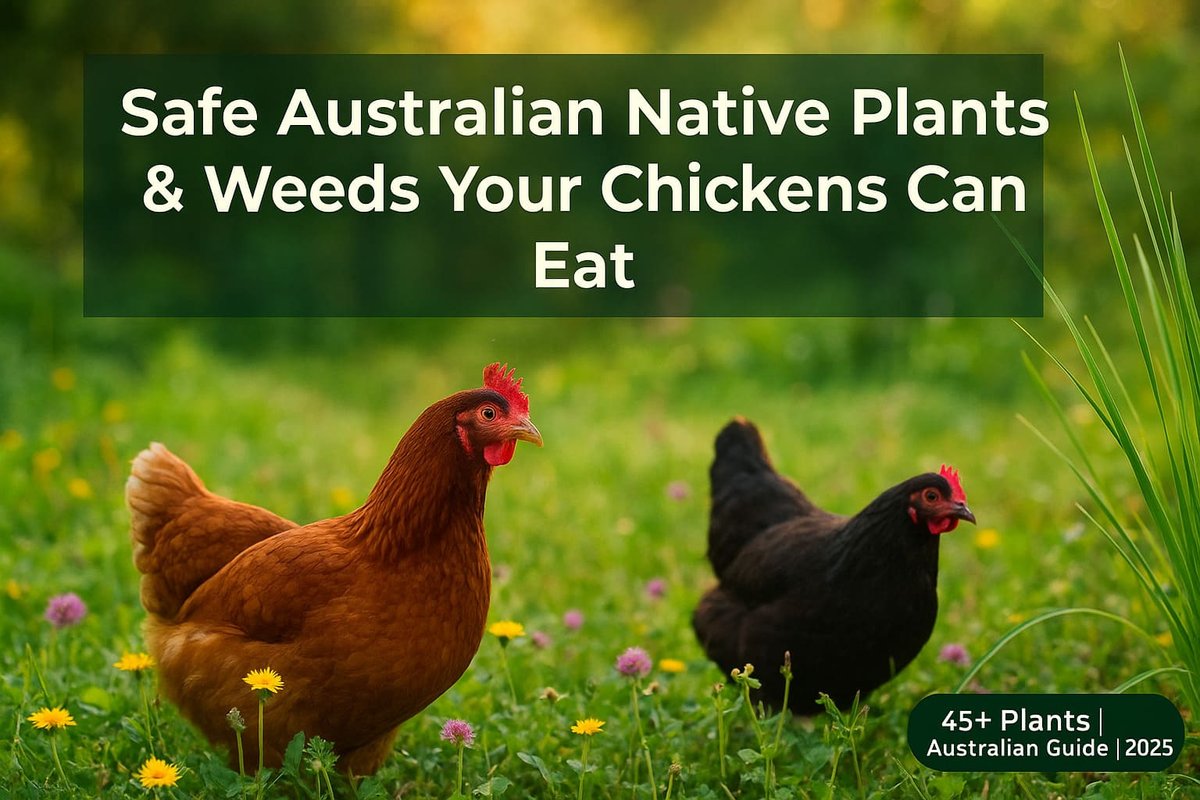
![Best Shade Cloth for Chicken Runs Australia 2025 [Complete Guide]](https://chickenstarter.com/wp-content/uploads/2025/11/Best-Shade-Cloth-for-Chicken-Runs-Australia-2025-Complete-Guide-1-300x164.jpg)
